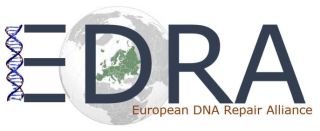|
|
|
18th EDRA webinar - December 16th, 202518th EDRA Webinar - December 16th, 2025, from 4:00 to 5:30 pm (CET)
Julian Stingele - Keynote speaker The Gene Center, Ludwig-Maximilians-Universität München, Munich, Germany The role of RNA damage in chemotherapy Excessive RNA damage activates cellular stress responses, triggering cell death. However, pathways that negatively regulate RNA damage responses are largely uncharacterized. Using genetic screens, we find that the ubiquitin ligase RNF25 provides tolerance to RNA damage caused by the nucleoside analogue azacytidine (aza-C), a chemotherapeutic agent used to treat acute myeloid leukemia (AML). Modifier screens reveal that the aza-C hypersensitivity of RNF25-deficient cells is suppressed by loss of the GCN2-dependent integrated stress response (ISR). Mechanistically, we show that the pyrimidine ring of azacytidine decomposes spontaneously within mRNA, creating a lesion that stalls elongating ribosomes. The resulting ribosome collisions are sensed by GCN1, leading to activation of the ISR by GCN2, which we identify as the primary driver of acute aza-C cytotoxicity in cell lines and in primary AML cells. RNF25 ubiquitylates stalled ribosomes and curbs the ISR by constraining GCN2 activation in response to aza-C and other sources of RNA damage. In the absence of RNF25, aza-C induces hyperactivation of the ISR, expression of pro-apoptotic factors, and ultimately cell death. Our work thus reveals how cells adjust the sensitivity of the RNA damage response to tolerate certain levels of RNA damage. Moreover, by showing that aza-C also causes cell death through induction of RNA damage in primary AML patient cells, we highlight RNA damage as a potentially critical component of chemosensitivity in AML.
Andre Bortolini Silveira - Short talk Institut Curie, Paris, France BER and MMR converge: decoding 5-methylcytosine deamination repair CpG dinucleotides are hotspots for mutagenesis by spontaneous deamination of 5-methylcytosine (5mC) into thymine, resulting in T:G mismatches that can lead to C>T transitions. These mutations are not only a hallmark of aging and cancer but also a major force shaping the evolution of vertebrate genomes. We have previously uncovered MBD4 as the primary base excision repair (BER) glycosylase responsible for 5mC deamination repair in both CpG and non-CpG contexts, with a striking preference for guarding active chromatin and early-replicating DNA. In this study, we employ a targeted base-editing system - comprising an APOBEC1 deaminase fused to a catalytically dead Cas9 -to induce precise and strand-specific cytosine deamination and track its repair. This approach allows us to systematically investigate the cellular components required for efficient 5mC deamination repair in human cells. Our data reveal that MBD4 cooperates with the mismatch repair (MMR) pathway outside of S-phase, implicating non-canonical MMR in the repair of this form of DNA damage. Using AI-based structural predictions alongside biochemical validation, we identify a previously unrecognized complex including MBD4 and MMR components, positioning them as key players in a coordinated repair response. Finally, we analyze thousands of tumor whole-genomes to show that MMR deficiency leads to CpG hypermutagenesis lacking replication strand asymmetry, further supporting a role for replication-independent MMR activity in 5mC deamination repair. Altogether, we uncover a novel function of non-canonical MMR that underscores its interplay with BER in safeguarding genomic integrity in mammalian cells.
Nicola Pietro Montaldo - Short talk Oslo University Hospital, Oslo, Norway Mitochondrial DNA Repair: A Key to Preventing Brain Battery Failure in Parkinson's Disease Nth-like DNA glycosylase (NTHL1) catalyzes the first step of base excision repair (BER), a pathway essential for maintaining the integrity of both nuclear and mitochondrial genomes. Our study shows that loss of NTHL1 leads to the accumulation of mitochondrial DNA (mtDNA) lesions, highlighting its critical role in safeguarding mitochondrial genomic stability. Unexpectedly, NTHL1 deficiency also results in increased mtDNA copy number, expanded mitochondrial mass, and enhanced respiratory capacity—features consistent with an adaptive mitochondrial response. NTHL1-knockout cells exhibit resistance to MPP⁺-induced mitochondrial stress, and RNA-seq analysis suggests that this phenotype arises from a complex and potentially non-canonical mitohormetic program.
|





